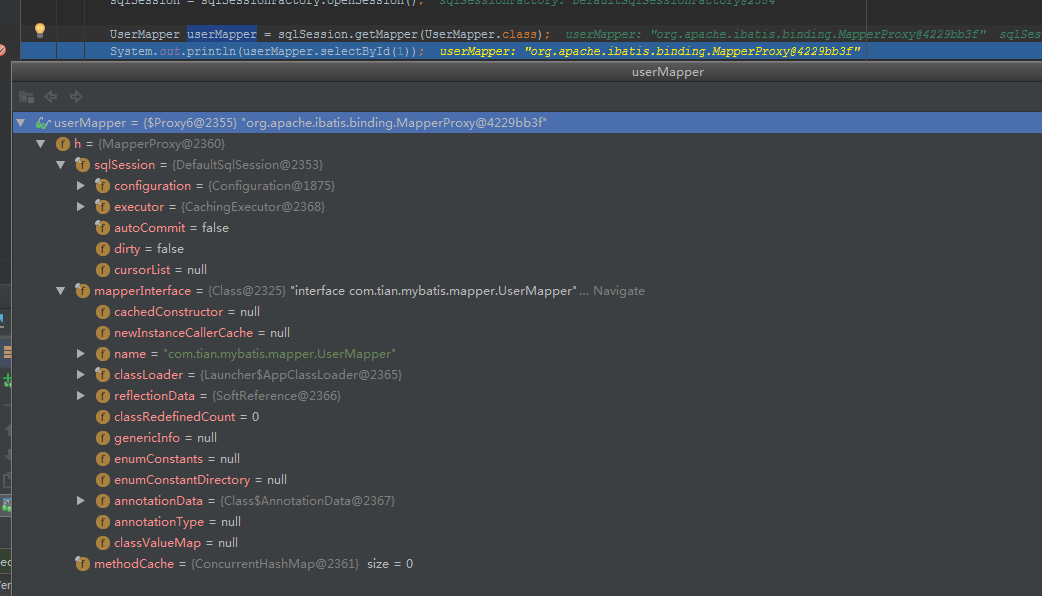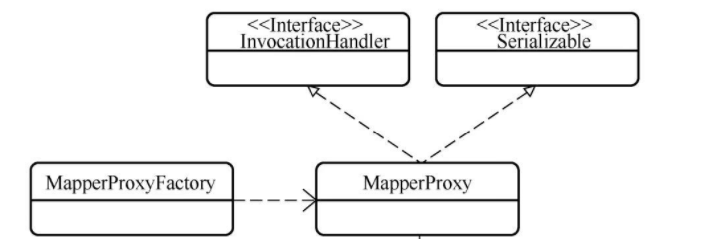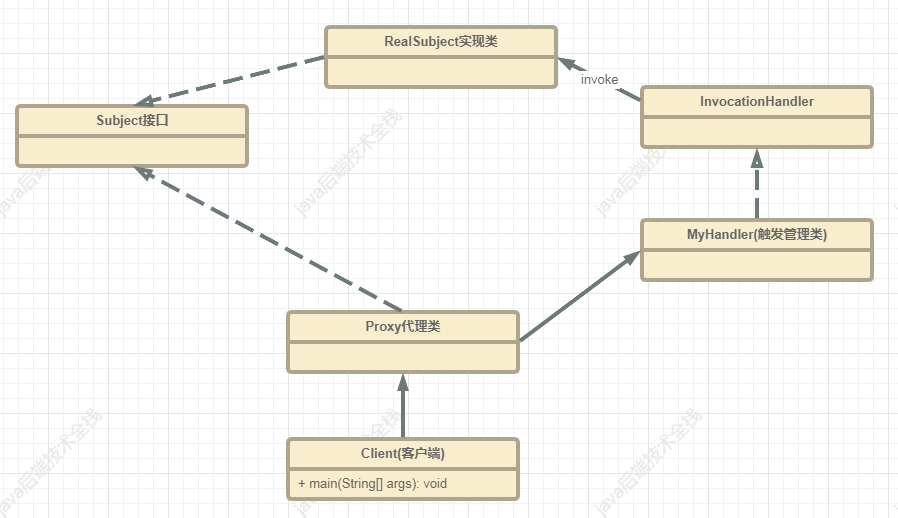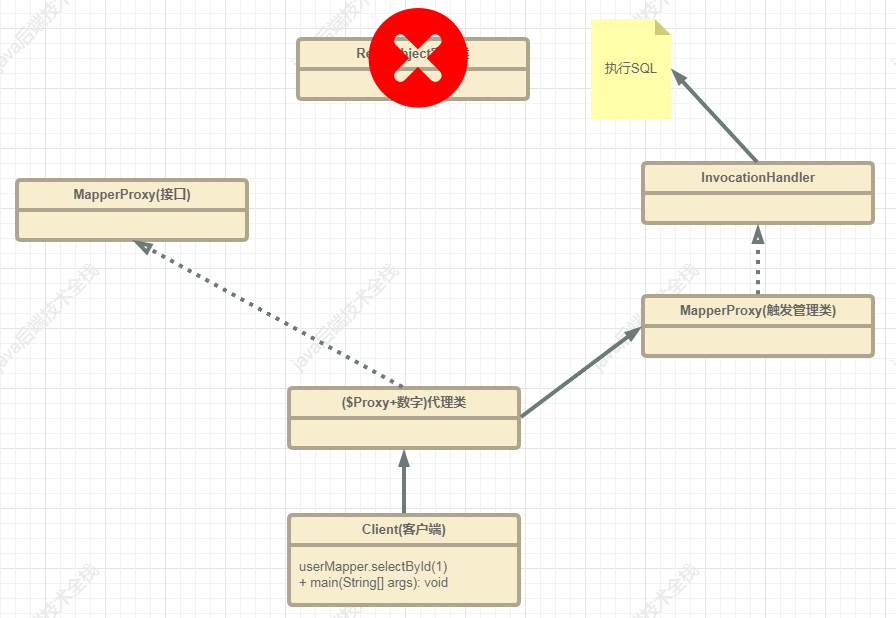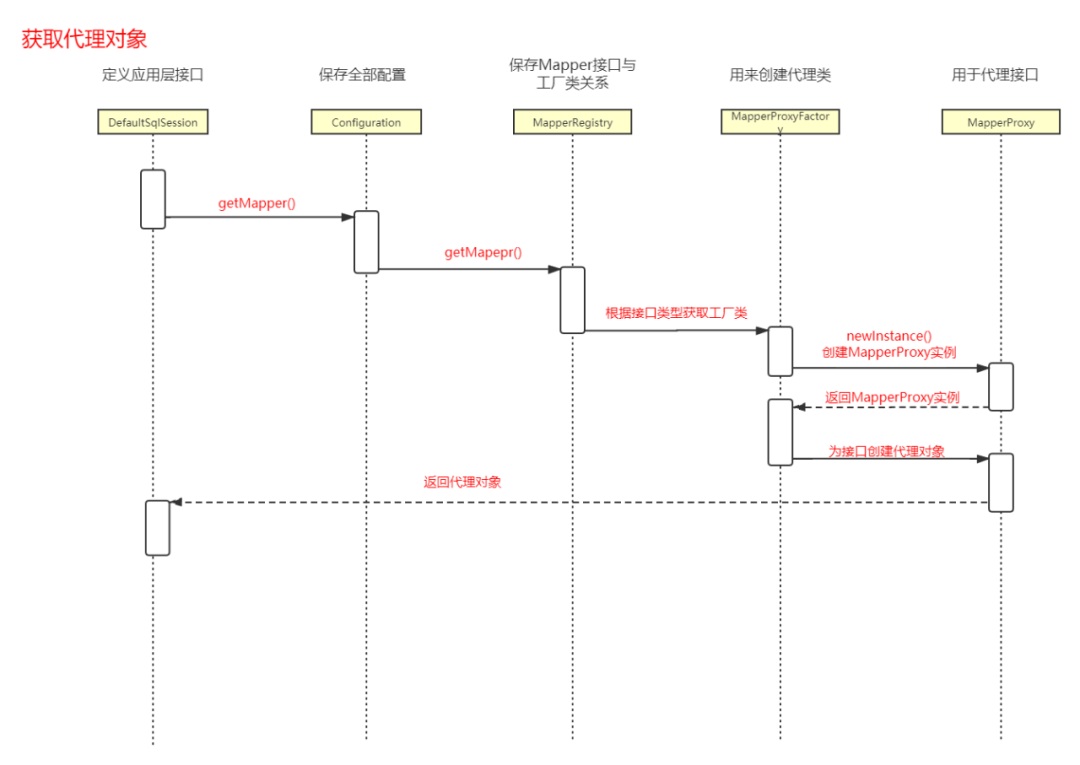美團面試:為什么就能直接調用userMapper接口的方法?
老規矩,先上案例代碼,這樣大家可以更加熟悉是如何使用的,看過Mybatis系列的小伙伴,對這段代碼差不多都可以背下來了。
哈哈~,有點夸張嗎?不夸張的,就這行代碼。
- public class MybatisApplication {
- public static final String URL = "jdbc:mysql://localhost:3306/mblog";
- public static final String USER = "root";
- public static final String PASSWORD = "123456";
- public static void main(String[] args) {
- String resource = "mybatis-config.xml";
- InputStream inputStream = null;
- SqlSession sqlSession = null;
- try {
- inputStream = Resources.getResourceAsStream(resource);
- SqlSessionFactory sqlSessionFactory = new SqlSessionFactoryBuilder().build(inputStream);
- sqlSession = sqlSessionFactory.openSession();
- //今天主要這行代碼
- UserMapper userMapper = sqlSession.getMapper(UserMapper.class);
- System.out.println(userMapper.selectById(1));
- } catch (Exception e) {
- e.printStackTrace();
- } finally {
- try {
- inputStream.close();
- } catch (IOException e) {
- e.printStackTrace();
- }
- sqlSession.close();
- }
- }
看源碼有什么用?
通過源碼的學習,我們可以收獲Mybatis的核心思想和框架設計,另外還可以收獲設計模式的應用。
前兩篇文章我們已經Mybatis配置文件解析到獲取SqlSession,下面我們來分析從SqlSession到userMapper:
- UserMapper userMapper = sqlSession.getMapper(UserMapper.class);
前面那篇文章已經知道了這里的sqlSession使用的是默認實現類DefaultSqlSession。所以我們直接進入DefaultSqlSession的getMapper方法。
- //DefaultSqlSession中
- private final Configuration configuration;
- //type=UserMapper.class
- @Override
- public <T> T getMapper(Class<T> type) {
- return configuration.getMapper(type, this);
- }
這里有三個問題:
問題1:getMapper返回的是個什么對象?
上面可以看出,getMapper方法調用的是Configuration中的getMapper方法。然后我們進入Configuration中
- //Configuration中
- protected final MapperRegistry mapperRegistry = new MapperRegistry(this);
- ////type=UserMapper.class
- public <T> T getMapper(Class<T> type, SqlSession sqlSession) {
- return mapperRegistry.getMapper(type, sqlSession);
- }
這里也沒做什么,繼續調用MapperRegistry中的getMapper:
- //MapperRegistry中
- public class MapperRegistry {
- //主要是存放配置信息
- private final Configuration config;
- //MapperProxyFactory 的映射
- private final Map<Class<?>, MapperProxyFactory<?>> knownMappers = new HashMap<>();
- //獲得 Mapper Proxy 對象
- //type=UserMapper.class,session為當前會話
- public <T> T getMapper(Class<T> type, SqlSession sqlSession) {
- //這里是get,那就有add或者put
- final MapperProxyFactory<T> mapperProxyFactory = (MapperProxyFactory<T>) knownMappers.get(type);
- if (mapperProxyFactory == null) {
- throw new BindingException("Type " + type + " is not known to the MapperRegistry.");
- }
- try {
- //創建實例
- return mapperProxyFactory.newInstance(sqlSession);
- } catch (Exception e) {
- throw new BindingException("Error getting mapper instance. Cause: " + e, e);
- }
- }
- //解析配置文件的時候就會調用這個方法,
- //type=UserMapper.class
- public <T> void addMapper(Class<T> type) {
- // 判斷 type 必須是接口,也就是說 Mapper 接口。
- if (type.isInterface()) {
- //已經添加過,則拋出 BindingException 異常
- if (hasMapper(type)) {
- throw new BindingException("Type " + type + " is already known to the MapperRegistry.");
- }
- boolean loadCompleted = false;
- try {
- //添加到 knownMappers 中
- knownMappers.put(type, new MapperProxyFactory<>(type));
- //創建 MapperAnnotationBuilder 對象,解析 Mapper 的注解配置
- MapperAnnotationBuilder parser = new MapperAnnotationBuilder(config, type);
- parser.parse();
- //標記加載完成
- loadCompleted = true;
- } finally {
- //若加載未完成,從 knownMappers 中移除
- if (!loadCompleted) {
- knownMappers.remove(type);
- }
- }
- }
- }
- }
MapperProxyFactory對象里保存了mapper接口的class對象,就是一個普通的類,沒有什么邏輯。
在MapperProxyFactory類中使用了兩種設計模式:
- 單例模式methodCache(注冊式單例模式)。
- 工廠模式getMapper()。
繼續看MapperProxyFactory中的newInstance方法。
- public class MapperProxyFactory<T> {
- private final Class<T> mapperInterface;
- private final Map<Method, MapperMethod> methodCache = new ConcurrentHashMap<>();
- public MapperProxyFactory(Class<T> mapperInterface) {
- this.mapperInterface = mapperInterface;
- }
- public T newInstance(SqlSession sqlSession) {
- //創建MapperProxy對象
- final MapperProxy<T> mapperProxy = new MapperProxy<>(sqlSession, mapperInterface, methodCache);
- return newInstance(mapperProxy);
- }
- //最終以JDK動態代理創建對象并返回
- protected T newInstance(MapperProxy<T> mapperProxy) {
- return (T) Proxy.newProxyInstance(mapperInterface.getClassLoader(), new Class[] { mapperInterface }, mapperProxy);
- }
- }
從代碼中可以看出,依然是穩穩的基于 JDK Proxy 實現的,而 InvocationHandler 參數是 MapperProxy 對象。
- //UserMapper 的類加載器
- //接口是UserMapper
- //h是mapperProxy對象
- public static Object newProxyInstance(ClassLoader loader,
- Class<?>[] interfaces,
- InvocationHandler h){
- }
問題2:為什么就可以調用他的方法?
上面調用newInstance方法時候創建了MapperProxy對象,并且是當做newProxyInstance的第三個參數,所以MapperProxy類肯定實現了InvocationHandler。
進入MapperProxy類中:
- //果然實現了InvocationHandler接口
- public class MapperProxy<T> implements InvocationHandler, Serializable {
- private static final long serialVersionUID = -6424540398559729838L;
- private final SqlSession sqlSession;
- private final Class<T> mapperInterface;
- private final Map<Method, MapperMethod> methodCache;
- public MapperProxy(SqlSession sqlSession, Class<T> mapperInterface, Map<Method, MapperMethod> methodCache) {
- this.sqlSession = sqlSession;
- this.mapperInterface = mapperInterface;
- this.methodCache = methodCache;
- }
- //調用userMapper.selectById()實質上是調用這個invoke方法
- @Override
- public Object invoke(Object proxy, Method method, Object[] args) throws Throwable {
- try {
- //如果是Object的方法toString()、hashCode()等方法
- if (Object.class.equals(method.getDeclaringClass())) {
- return method.invoke(this, args);
- } else if (method.isDefault()) {
- //JDK8以后的接口默認實現方法
- return invokeDefaultMethod(proxy, method, args);
- }
- } catch (Throwable t) {
- throw ExceptionUtil.unwrapThrowable(t);
- }
- //創建MapperMethod對象
- final MapperMethod mapperMethod = cachedMapperMethod(method);
- //下一篇再聊
- return mapperMethod.execute(sqlSession, args);
- }
- }
也就是說,getMapper方法返回的是一個JDK動態代理對象(類型是$Proxy+數字)。這個代理對象會繼承Proxy類,實現被代理的接口UserMpper,里面持有了一個MapperProxy類型的觸發管理類。
當我們調用UserMpper的方法時候,實質上調用的是MapperProxy的invoke方法。
- userMapper=$Proxy6@2355。
為什么要在MapperRegistry中保存一個工廠類?
原來他是用來創建并返回代理類的。這里是代理模式的一個非常經典的應用。
MapperProxy如何實現對接口的代理?
JDK動態代理
我們知道,JDK動態代理有三個核心角色:
- 被代理類(即就是實現類)
- 接口
- 實現了InvocationHanndler的觸發管理類,用來生成代理對象。
被代理類必須實現接口,因為要通過接口獲取方法,而且代理類也要實現這個接口。
而Mybatis中并沒有Mapper接口的實現類,怎么被代理呢?它忽略了實現類,直接對Mapper接口進行代理。
MyBatis動態代理:
在Mybatis中,JDK動態代理為什么不需要實現類呢?
這里我們的目的其實就是根據一個可以執行的方法,直接找到Mapper.xml中statement ID ,方便調用。
最后返回的userMapper就是MapperProxyFactory的創建的代理對象,然后這個對象中包含了MapperProxy對象,
問題3:到底是怎么根據Mapper.java找到Mapper.xml的?
最后我們調用userMapper.selectUserById(),本質上調用的是MapperProxy的invoke()方法。
請看下面這張圖:
如果根據(接口+方法名找到Statement ID ),這個邏輯在InvocationHandler子類(MapperProxy類)中就可以完成了,其實也就沒有必要在用實現類了。
總結
本文中主要是講getMapper方法,該方法實質上是獲取一個JDK動態代理對象(類型是Proxy+數字),這個代理類會繼承MapperProxy類,實現被代理的接口UserMapper,并且里面持有一個MapperProxy類型的觸發管理類。這里我們就拿到代理類了,后面我們就可以使用這個代理對象進行方法調用。
問題涉及到的設計模式:
- 代理模式。
- 工廠模式。
- 單例模式。
整個流程圖:
本文轉載自微信公眾號「Java后端技術全棧」,可以通過以下二維碼關注。轉載本文請聯系Java后端技術全棧公眾號。















